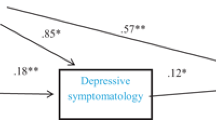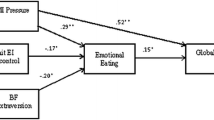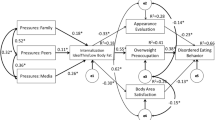Abstract
This study aimed to explore the role of depression as a moderator of sociocultural influences on eating disorder symptoms. A sample of 509 adolescents (56% female) completed self-report questionnaires assessing depression, body dissatisfaction, drive for thinness, bulimic symptoms and sociocultural influences on appearance from family, peers and the media. Both girls and boys displaying high levels of depressive symptoms perceived stronger media and peer influences on appearance. Among girls, eating disorder symptoms were directly affected by sociocultural influences, in particular media influences, as well as by depression. However, depression played only a limited role as a moderator of these relationships. Among boys, sociocultural influences and depression revealed fewer direct effects on eating disorder symptoms. However, depression had a greater moderating effect on these relationships. Future research into the role of depression may increase the understanding of gender differences in body dissatisfaction, drive for thinness and bulimic symptoms.
Similar content being viewed by others
References
Aiken, L. S., & West, S. G. (1991). Multiple regression: Testing and interpreting interactions. CA: Sage.
Archinard, M., Rouget, P., Painot, D., & Liengne, C. (1996). In M. Bouvard & J. Cottraux (Eds.), Protocoles et échelles d’évaluation en psychiatrie et en psychologie. Paris: Masson.
Ata, R. N., Bryant Ludden, A., & Lally, M. M. (2007). The effects of gender and family, friend, and media influences on eating behaviors and body image during adolescence. Journal of Youth and Adolescence, 36, 1024–1037.
Baron, R. M., & Kenny, D. A. (1986). The moderator-mediator variable distinction in social psychological research: Conceptual, strategic, and statistical considerations. Journal of Personality and Social Psychology, 51, 1173–1182.
Chabrol, H., Montovany, A., Chouicha, K., Ducongé, E., Massot, E., & Kallmeyer, A. (2002). Etude de la CES-D dans un échantillon de 1953 adolescents scolarisés. Encéphale, 28, 429–432.
Chabrol, H., Rodgers, R., & Rousseau, A. (2007). Relations between suicidal ideation and dimensions of depressive symptoms in high-school students. Journal of Adolescence, 30, 587–600.
Dittmar, H. (2005). Vulnerability factors and processes linking sociocultural pressures and body dissatisfaction. Journal of Social and Clinical Psychology, 24, 1081–1087.
Fabian, L. J., & Thompson, J. K. (1989). Body image and eating disturbance in young females. International Journal of Eating Disorders, 8, 63–74.
Fuhrer, R., & Rouillon, F. (1989). La version française de l’échelle CES-D. Description et traduction de l’échelle d’auto-évaluation. Psychiatrie et Psychobiologie, 4, 163–166.
Garner, D. M., Olmsted, M. P., & Polivy, J. (1983). Development and validation of a multidimensional eating disorder inventory for anorexia nervosa and bulimia. International Journal of Eating Disorders, 2, 15–34.
Gila, A., Castro, J., Cesena, J., & Toro, J. (2005). Anorexia nervosa in male adolescents: body image, eating attitudes and psychological traits. Journal of Adolescent Health, 36, 221–226.
Halliwell, E., & Harvey, M. (2006). Examination of a sociocultural model of disordered eating among male and female adolescents. British Journal of Health Psychology, 11, 235–248.
Jones, D. C. (2004). Body image among adolescent girls and boys: A longitudinal study. Developmental Psychology, 40(5), 823–835.
Keery, H., van den Berg, P., & Thompson, J. K. (2004). An evaluation of the tripartite influence model of body dissatisfaction and eating disturbance with adolescent girls. Body image, 1, 237–251.
Knauss, C., Paxton, S. J., & Alsaker, F. D. (2007). Relationships amongst body dissatisfaction, internalisation of the media body ideal and perceived pressure from the media in adolescent girls and boys. Body Image, 4, 353–360.
Knauss, C., Paxton, S. J., & Alsaker, F. D. (2008). Body dissatisfaction in adolescent boys and girls: Objectified body consciousness internalization of the media body ideal and perceived pressure from the media. Sex Roles, 59, 633–643.
Koenig, L. J., & Wasserman, E. L. (1995). Body image and dieting failure in college men and women: Examining links between depression and eating problems. Sex Roles, 32, 225–249.
Leon, G. R., Fulkerson, J. A., Perry, C. L., Keel, P. K., & Klump, K. L. (1999). Three to four year prospective and behavioral risk factors for later disordered eating in adolescent boys and girls. Journal of Youth and Adolescence, 28, 181–196.
Levine, M. P., Smolak, L., & Hayden, H. (1994). The relation of sociocultural factors to eating attitudes and behaviors among middle school girls. Journal of Early Adolescence, 14, 471–490.
McCabe, M. P., & Ricciardelli, L. A. (2006). A prospective study of extreme weight change behaviors among adolescent boys and girls. Journal of Youth and Adolescence, 35(3), 425–434.
McCabe, M. P., Ricciardelli, L. A., & Banfield, S. (2001). Body image and strategies to change muscle and puberty: Do they impact on positive and negative affect among adolescent boys and girls? Eating Behaviors, 2, 129–149.
McCarthy, M. (1990). The thin ideal, depression and eating disorders in women. Behaviour Research and Therapy, 28, 202–215.
McCauley, M., Mintz, L., & Glenn, A. A. (1988). Body image, self esteem and depression proneness: Closing the gender gap. Sex Roles, 18, 381–391.
Meno, C. A., Hannum, J. A., Espelage, D. E., & Douglas Low, K. S. (2008). Familial and individual variables as predictors of dieting concerns and binge eating in college females. Eating behaviors, 9, 91–101.
Nolen-Hoeskesema, S., & Girgus, J. S. (1994). The emergence of gender differences in depression during adolescence. Psychological Bulletin, 115(3), 424–443.
Paxton, S. J., Eisenberg, M. E., & Neumark-Sztainer, D. (2006a). Prospective predictors of body dissatisfaction in adolescent girls and boys: A five-year longitudinal study. Developmental Psychology, 42(5), 888–899.
Paxton, S. J., Neumark-Sztainer, D., Hannan, P. J., & Eisenberg, M. E. (2006b). Body dissatisfaction prospectively predicts depressive mood and low self-esteem in adolescent girls and boys. Journal of Clinical Child and Adolescent Psychology, 35(4), 539–549.
Paxton, S. J., Norris, M., Wertheim, E. H., Durkin, S. J., & Anderson, J. (2005). Body dissatisfaction, dating, and the importance of thinness to attractiveness in adolescent girls. Sex Roles, 53, 663–675.
Paxton, S. J., Wertheim, E. H., Gibbons, K., Szmukler, G. I., Hillier, L., & Petrovich, J. L. (1991). Body image satisfaction, dieting beliefs, and weight loss behaviors in adolescent girls and boys. Journal of Youth and Adolescence, 20, 361–379.
Peterson, K. A., Paulson, S. A., & Williams, K. K. (2007). Relations of eating disorder symptomatology with perceptions of pressures from mother, peers, and media in adolescent girls and boys. Sex Roles, 57, 629–639.
Presnell, K., Bearman, S. K., & Stice, E. (2004). Risk factors for body dissatisfaction in adolescent boys and girls: A prospective study. International Journal of Eating Disorders, 36, 389–401.
Radloff, L. (1977). The CES-D scale: A self-report depression scale for research in the general population. Applied Psychological Measurement, 1, 385–401.
Ricciardelli, L. A., & McCabe, M. P. (2001). Self-esteem and negative affect as moderators of sociocultural influences on body dissatisfaction, strategies to decrease weight, and strategies to increase muscles among adolescent girls and boys. Sex Roles, 44, 189–207.
Ricciardelli, L. A., & McCabe, M. P. (2003). A longitudinal analysis of the role of biopsychosocial factors in predicting body change strategies among adolescent boys. Sex Roles, 45, 349–360.
Roberts, R. E., Lewinshon, P. M., & Seeley, P. R. (1991). Screening for adolescent depression: A comparison of depression scales. Journal of the American Academy of Child and Adolescent Psychiatry, 30, 58–66.
Rodgers, R., & Chabrol, H. (2009). Parental attitudes, body image disturbance and disordered eating amongst adolescents and young adults: A review. European Eating Disorders Review, 17, 137–151.
Santos, M., Richards, C. S., & Bleckley, M. K. (2007). Comorbidity between depression and disordered eating in adolescents. Eating behaviors, 8, 440–449.
Schutz, H. K., & Paxton, S. J. (2007). Friendship quality, body dissatisfaction, dieting and disordered eating in adolescents. British Journal of Clinical Psychology, 46, 67–83.
Shore, R. A., & Porter, J. E. (1990). Normative and reliability data from 11 to 18 year olds on the eating disorders inventory. International Journal of Eating Disorders, 9, 201–207.
Spoor, S. T. P., Stice, E., Bekker, M. H., Van Strien, T., Croon, M. A., & Van Heck, G. L. (2006). Relations between dietary restraint, depressive symptoms, and binge eating: A longitudinal study. International Journal of Eating Disorders, 39, 700–707.
Stice, E. (2002). Risk and maintenance factors for eating pathology: A meta-analytic review. Psychological Bulletin, 128, 825–848.
Stice, E., Akutagawa, D., Gaggar, A., & Agras, A. W. (2000). Negative affect moderates the relations between dieting and binge eating. International Journal of Eating Disorders, 27, 218–229.
Stice, E., Maxfield, J., & Wells, T. (2003). Adverse effects of social pressure to be thin on young women: An experimental investigation of the effects of “fat talk”. International Journal of Eating Disorders, 34(10), 8–117.
Stice, E., Spangler, D., & Agras, W. S. (2001). Exposure to media-portrayed thin-ideal images adversely affects vulnerable girls: A longitudinal study. Journal of Social and Clinical Psychology, 20, 270–288.
Suisman, J. L., Slane, J. D., Burt, S. A., & Klump, K. L. (2008). Negative affect as a mediator of the relationships between weight-based teasing and binge eating in adolescent girls. Eating Behaviors, 9, 493–496.
Tiggemann, M. (2005). The state of body image research in clinical and social psychology. Journal of Social and Clinical Psychology, 24(8), 1202–1210.
Tiggemann, M., & McGill, B. (2004). The role of social comparison in the effect of magazine advertisements on women’s mood and body dissatisfaction. Journal of Social and Clinical Psychology, 23(1), 23–44.
Tomori, M., & Rus-Makovec, M. (2000). Eating behavior, depression, and self-esteem in high school students. Journal of Adolescent Health, 26, 361–367.
van den Berg, P., Paxton, S. J., Keery, H., Wall, M., Guo, J., & Neumark-Sztainer, D. (2007). Body dissatisfaction and body comparison with media images in males and females. Body Image, 4, 257–268.
Vincent, M. A., & McCabe, M. P. (2000). Gender differences among adolescents in family, and peer influences on body dissatisfaction, weight loss, and binge eating behaviors. Journal of Youth and Adolescence, 29, 205–221.
Vogt Yuan, A. S. (2007). Gender differences in the relationship of puberty with adolescents’ depressive symptoms: Do body perceptions matter? Sex Roles, 57, 69–80.
Wertheim, E. H., Mee, V., & Paxton, S. J. (1999). Relationships among adolescent girls’ eating behaviors and their parents’ weight-related attitudes and behaviors. Sex Roles, 41, 169–187.
Author information
Authors and Affiliations
Corresponding author
Rights and permissions
About this article
Cite this article
Rodgers, R.F., Paxton, S.J. & Chabrol, H. Depression as a Moderator of Sociocultural Influences on Eating Disorder Symptoms in Adolescent Females and Males. J Youth Adolescence 39, 393–402 (2010). https://doi.org/10.1007/s10964-009-9431-y
Received:
Accepted:
Published:
Issue Date:
DOI: https://doi.org/10.1007/s10964-009-9431-y




